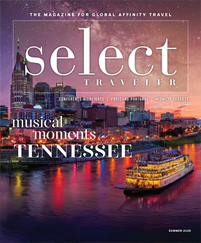Is there anything more appealing than a great waterfront view?
Along the South’s Atlantic and Gulf coasts, cities and towns leverage scenic settings to create memorable visitor experiences. With miles of pristine beaches, beautiful islands, and history and culture that date back to the country’s earliest settlers, these six Southern waterfront destinations are perfect places for groups to get away from the frantic pace of urban life and commune with nature.
Gulf Shores and Orange Beach, Alabama
Located in one of the most biodiverse areas in the country, Alabama’s Gulf Shores and Orange Beach serve as a crucial flyover point for migratory birds and monarch butterflies, a nesting area for three endangered species of sea turtles, and home to the largest artificial reef program in the U.S.
Groups can explore the area’s white sand beaches, go snorkeling or diving in the crystal blue waters, or book charter fishing expeditions. Stand-up paddleboarding, kayaking, boating and dolphin cruises are a must for any group visiting this beautiful destination. Gulf State Park features nine distinct ecosystems, three freshwater lakes, the largest fishing pier on the Gulf of Mexico and more than 28 miles of accessible trails. Many of the area’s accommodations are also beachfront, including two full-service resorts.
Visitors will want to tour Fort Morgan, a masonry fort built between 1819 and 1833 that stands guard where Mobile Bay meets the Gulf of Mexico, or Fort Gaines, which sits on the eastern tip of Dauphin Island. Both forts played a major role in the Battle of Mobile Bay in 1864. Visitors can also step aboard the USS Alabama Battleship and USS Drum submarine at USS Alabama Battleship Memorial Park.
St. Augustine, Florida
Founded in 1865, St. Augustine is the oldest city in the United States. Not only is it a major historical destination, but it is also known for its beautiful sandy beaches and water sports.
One of the most iconic structures in the city, Castillo de San Marcos National Monument, overlooks the city’s bayfront. The Spanish fort, which was built from 1672 to 1790 is the oldest masonry fort in the U.S. and the only standing 17th century military construction in the country.
Much of the city’s rich history took place along the waterfront. Groups can visit several historical sites there, including the St. Augustine Lighthouse and Maritime Museum, which details the city’s rich maritime history and allows guests to climb the 219 steps to the top for an eagle’s eye view of St. Augustine and the Florida coast.
Ponce de Leon’s Fountain of Youth Archaeological Park is believed to be where the Spanish explorer and conquistador came ashore in 1513. It offers exhibits, demonstrations, shows and reenactments across 15 acres. Groups can visit Fort Mose Historic State Park, just north of the city, which is the first free slave settlement in North America. It was sanctioned by the Spanish in the late 1600s and was where runaway slaves would come to seek freedom. Along with an interactive museum and self-guided Flight to Freedom Trail, the park also offers opportunities for birding and wildlife viewing on the waterfront.
Bay St. Louis, Mississippi
Bay St. Louis is a small town on Mississippi’s Gulf Coast where visitors can park their boats in the middle of town to wander the downtown area, eat at its many local restaurants and listen to live music at several waterfront clubs.
The Depot District, about six blocks from the water, is centered around the L&N Railroad Depot, which was built in 1927 and includes boutique shops, restaurants and bars. The area has an expansive green space that offers free live music during the spring and fall.
Groups can take charter boats from the pier to Cat Island for fishing or a relaxing day trip, rent kayaks to get out on the water, or host a barbecue or crab boil on the beach.
The town is a great jumping-off point for visiting the entirety of coastal Mississippi, including 12 casinos and seven golf courses. The Mississippi Aquarium in Gulfport features more than 200 species of animals and 50 species of native plants. Groups can also make a day trip to Ship Island or take a sunset cruise out of Biloxi or Gulfport. The area is known for its fresh seafood.
Southport, North Carolina
In North Carolina, Southport is located where the Cape Fear River, Atlantic Ocean and Intracoastal Waterway come together. The historic city has a rich maritime past that is on display at the North Carolina Maritime Museum at Southport and is an ideal gateway for exploring all the Brunswick Islands have to offer.
Southport is a very walkable city with art galleries, historic homes and unique shops. History buffs will enjoy a visit to Fort Johnston, a fort from Revolutionary times with a Garrison house that is now a museum and welcome center. A self-guided walking tour of the town takes visitors past historic homes and businesses, as well as downtown film locations.
There are five islands in the Brunswick Islands and six beaches. Groups can take a ferry from Southport to Kure Beach or Bald Head Island. On Kure Beach are miles of unspoiled beach and a quaint coastal town. Groups can also tour Fort Fisher State Historic Site, the location of the largest land-sea battle of the Civil War. The North Carolina Aquarium at Fort Fisher is another must-see stop.
From Southport’s waterfront, visitors can see the Bald Island Lighthouse and the Oak Island Lighthouse, which is the oldest lighthouse in North Carolina. Groups can book fishing charters out of Southport or play golf at several courses in the area. There are several places to rent paddleboards and kayaks or take a guided kayak tour.
Georgetown and Hammock Coast, South Carolina
South Carolina’s Hammock Coast is located between Myrtle Beach and Charleston, stretching from Garden City to Georgetown. The area is known for its stunning beaches, scenic islands and water activities. The vibe is more laid back and nature-centric than the larger cities on the coast, and every small town has its own charm.
Georgetown, the third-oldest city in South Carolina, has a wonderful historic district along Front Street with a boardwalk called the Harborwalk that goes along the Sampit River.
Pawleys Island is known as the oldest seaside resort in America, dating back to the 1700s, and Murrells Inlet is a former fishing village that is considered the seafood capital of South Carolina. Huntington Beach State Park, Brookgreen Gardens and Waccamaw National Wildlife Refuge are all worth a visit.
There are thousands of acres of preserved land along the coast, including marshland and longleaf pine forest. Before the Civil War, multiple plantations there produced rice. Groups can take boat tours out of Georgetown that will take them around the former plantations and the Georgetown Lighthouse, which is only accessible by boat.
Norfolk, Virginia
Located in the heart of coastal Virginia, near Chesapeake Bay, Norfolk is a walkable waterfront destination with 144 miles of shoreline. It is also home to the world’s largest naval base, which brings in people from around the world.
The Nauticus discovery center in downtown gives a great overview of the city’s maritime history. Visitors can explore the last battleship ever built by the U.S. Navy, the USS Wisconsin, which is moored outside, as well as the Schooner Virginia, a reproduction of the last all-sail vessel built for the Virginia Pilot Association.
The area is perfectly suited for kayaking, sailing and boating. Groups can explore the Elizabeth River Trail, a 10.5-mile urban trail that connects Norfolk’s working waterfront with scenic routes that wend past historic landmarks and 28 neighborhoods. The city also is home to the Norfolk Botanical Garden and Virginia Zoo. Groups can take a walking tour that highlights the city’s architecture, murals and Neon District, which includes the world-renowned Chrysler Museum of Art. The museum has one of the largest glass-art collections in the country and gives glass-blowing demonstrations in its Perry Glass Studio.









